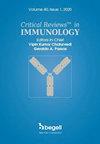Enhancing Human Treg Cell Induction through Engineered Dendritic Cells and Zinc Supplementation
IF 0.9
4区 医学
Q4 IMMUNOLOGY
引用次数: 0
Abstract
Regulatory T (Treg) cells hold promise for the ultimate cure of immune-mediated diseases. However, how to effectively restore Treg function in patients remains unknown. Previous reports suggest that activated dendritic cells (DCs) de novo synthesize locally high concentrations of 1,25-dihydroxy vitamin D, i.e., the active vitamin D or 1,25(OH)2D by upregulating the expression of 25-hydroxy vitamin D 1α-hydroxylase. Although 1,25(OH)2D has been shown to induce Treg cells, DC-derived 1,25(OH)2D only serves as a checkpoint to ensure well-balanced immune responses. Our animal studies have shown that 1,25(OH)2D requires high concentrations to generate Treg cells, which can cause severe side effects. In addition, our animal studies have also demonstrated that dendritic cells (DCs) overexpressing the 1α-hydroxylase de novo synthesize the effective Treg-inducing 1,25(OH)2D concentrations without causing the primary side effect of hypercalcemia (i.e., high blood calcium levels). This study furthers our previous animal studies and explores the efficacy of the 1α-hydroxylase-overexpressing DCs in inducing human CD4+FOXP3+ regulatory T (Treg) cells. We discovered that the Treg-inducing doses of 1,25(OH)2D were within a range, not the higher, the better. Additionally, our data corroborated that the 1α-hydroxylase-overexpressing DCs synthesized 1,25(OH)2D within this concentration range in vivo, thus facilitating effective Treg cell induction. Moreover, this study demonstrated that α-hydroxylase expression levels were pivotal for DCs to induce Treg cells because physiological 25(OH)D levels were sufficient for the engineered but not parental DCs to enhance Treg cell induction. Int通过工程树突状细胞和锌补充剂增强人类 Treg 细胞诱导能力
调节性 T(Treg)细胞有望最终治愈免疫介导疾病。然而,如何有效恢复患者的 Treg 功能仍是未知数。以前的报告表明,活化的树突状细胞(DC)通过上调 25- 羟基维生素 D 1α- 羟化酶的表达,在局部从头合成高浓度的 1,25-二羟基维生素 D,即活性维生素 D 或 1,25(OH)2D。虽然 1,25(OH)2D 已被证明能诱导 Treg 细胞,但 DC 衍生的 1,25(OH)2D 只是确保免疫反应平衡的一个检查点。我们的动物实验表明,1,25(OH)2D 需要高浓度才能生成 Treg 细胞,而高浓度会导致严重的副作用。此外,我们的动物实验还证明,过表达 1α- 羟化酶的树突状细胞(DCs)能从头合成有效的 Treg 诱导浓度的 1,25(OH)2D,而不会引起高钙血症(即高血钙)这一主要副作用。这项研究进一步推进了我们之前的动物实验,并探索了1α-羟化酶外表达的DC在诱导人类CD4+FOXP3+调节性T(Treg)细胞方面的功效。我们发现,1,25(OH)2D的Treg诱导剂量在一定范围内,并非越高越好。此外,我们的数据还证实,1α-羟化酶脱表达的DC在体内合成的1,25(OH)2D也在这个浓度范围内,从而促进了Treg细胞的有效诱导。此外,这项研究还证明了α-羟化酶的表达水平是DC诱导Treg细胞的关键,因为生理25(OH)D水平足以使工程DC而非亲代DC增强Treg细胞诱导。中
本文章由计算机程序翻译,如有差异,请以英文原文为准。
求助全文
约1分钟内获得全文
求助全文
来源期刊
CiteScore
2.60
自引率
0.00%
发文量
14
审稿时长
>12 weeks
期刊介绍:
Immunology covers a broad spectrum of investigations at the genes, molecular, cellular, organ and system levels to reveal defense mechanisms against pathogens as well as protection against tumors and autoimmune diseases. The great advances in immunology in recent years make this field one of the most dynamic and rapidly growing in medical sciences. Critical ReviewsTM in Immunology (CRI) seeks to present a balanced overview of contemporary adaptive and innate immune responses related to autoimmunity, tumor, microbe, transplantation, neuroimmunology, immune regulation and immunotherapy from basic to translational aspects in health and disease. The articles that appear in CRI are mostly obtained by invitations to active investigators. But the journal will also consider proposals from the scientific community. Interested investigators should send their inquiries to the editor before submitting a manuscript.

 求助内容:
求助内容: 应助结果提醒方式:
应助结果提醒方式:


